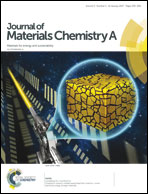Flexible high-energy asymmetric supercapacitors based on MnO@C composite nanosheet electrodes†
Abstract
Developing asymmetric supercapacitors (ASCs) is a promising alternative to achieve both wide voltage windows and high energy densities to meet the application requirements of hybrid vehicles and renewable energy systems. However, a major limitation of high performance asymmetric supercapacitors lies in negative electrode materials which possess relatively low specific capacitance compared to positive electrode materials. Herein, a novel MnO@C composite nanosheet array directly grown on conductive carbon cloth as a negative electrode is prepared successfully, which exhibits a large specific capacitance of 662.9 F g−1 at a current density of 3.7 A g−1 and an areal capacitance of 716 mF cm−2 at a current density of 4 mA cm−2. Afterward, a flexible ASC is successfully assembled with Co3O4 nanosheets and MnO@C nanosheets as the positive electrode and negative electrode, respectively. The optimized ASC achieves a high operating voltage of 1.7 V and displays intriguing performances with a high specific capacitance of 166 F g−1, an exceptional energy density of 59.6 W h kg−1 and superior rate capability and cycling stability. In addition, the ASC exhibits superior flexibility and mechanical stability even under severe bending states. The ASC based on MnO@C nanosheets as a promising candidate for high performance supercapacitors may pave the way for applications in high performance energy storage systems.



 Please wait while we load your content...
Please wait while we load your content...